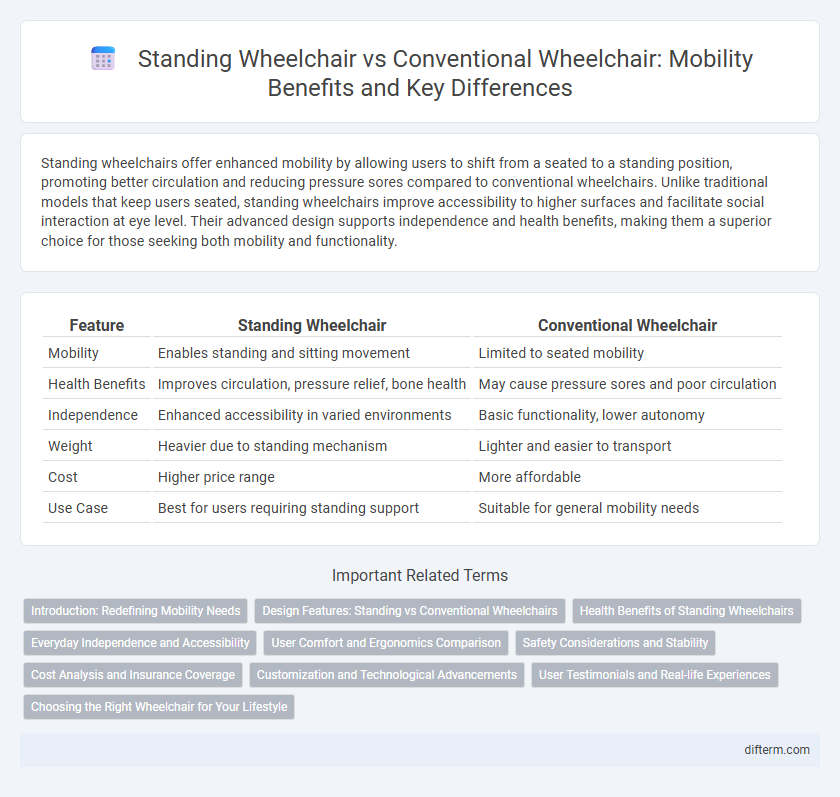Standing wheelchairs offer enhanced mobility by allowing users to shift from a seated to a standing position, promoting better circulation and reducing pressure sores compared to conventional wheelchairs. Unlike traditional models that keep users seated, standing wheelchairs improve accessibility to higher surfaces and facilitate social interaction at eye level. Their advanced design supports independence and health benefits, making them a superior choice for those seeking both mobility and functionality.
Table of Comparison
| Feature | Standing Wheelchair | Conventional Wheelchair |
|---|---|---|
| Mobility | Enables standing and sitting movement | Limited to seated mobility |
| Health Benefits | Improves circulation, pressure relief, bone health | May cause pressure sores and poor circulation |
| Independence | Enhanced accessibility in varied environments | Basic functionality, lower autonomy |
| Weight | Heavier due to standing mechanism | Lighter and easier to transport |
| Cost | Higher price range | More affordable |
| Use Case | Best for users requiring standing support | Suitable for general mobility needs |
Introduction: Redefining Mobility Needs
Standing wheelchairs transform mobility by enabling users to shift from sitting to standing positions, improving circulation and independence. Compared to conventional wheelchairs, they offer enhanced functionality for daily activities and social interaction. This innovation addresses unique mobility challenges, promoting physical health and psychological well-being.
Design Features: Standing vs Conventional Wheelchairs
Standing wheelchairs integrate advanced ergonomic designs with motorized mechanisms that allow users to shift from a seated to an upright position, enhancing pressure relief, circulation, and social interaction. Conventional wheelchairs typically prioritize lightweight frames and foldability for portability but lack the dynamic posture adjustment found in standing wheelchairs. Key design features of standing wheelchairs include reinforced frames, tilt and recline functions, and customizable support systems tailored to promote stability and comfort during standing transitions.
Health Benefits of Standing Wheelchairs
Standing wheelchairs improve circulation and reduce the risk of pressure sores by allowing users to change posture from sitting to standing, promoting weight distribution and muscle activity. These wheelchairs support bone density and joint health by enabling partial or full weight-bearing, which decreases the risk of osteoporosis and contractures commonly seen in prolonged sitting. Improved digestive and respiratory functions result from the upright position, enhancing overall well-being for individuals with mobility impairments.
Everyday Independence and Accessibility
Standing wheelchairs enhance everyday independence by allowing users to transition between sitting and standing positions, promoting better mobility and access to various environments. They improve accessibility in daily tasks by enabling eye-level interactions and easier reach of objects, surpassing the limitations of conventional wheelchairs. This functionality supports greater autonomy and social inclusion for individuals with mobility impairments.
User Comfort and Ergonomics Comparison
Standing wheelchairs enhance user comfort by enabling posture changes that reduce pressure sores and improve circulation, offering ergonomic benefits not typically found in conventional wheelchairs. These devices provide adjustable support that aligns with natural body mechanics, promoting spinal health and reducing muscle stiffness. Conventional wheelchairs often lack these dynamic positioning features, potentially leading to discomfort during prolonged use.
Safety Considerations and Stability
Standing wheelchairs offer enhanced safety features by allowing users to change posture and reduce pressure points, lowering the risk of pressure ulcers compared to conventional wheelchairs. Their design includes robust support systems and wider bases, which improve stability during movement and transitions between sitting and standing positions. Conventional wheelchairs, while lighter and simpler, may pose greater tipping risks and provide less posture support, impacting overall user safety.
Cost Analysis and Insurance Coverage
Standing wheelchairs generally have higher upfront costs compared to conventional wheelchairs, often ranging from $15,000 to $40,000 depending on features and customization, whereas conventional wheelchairs typically cost between $500 and $5,000. Insurance coverage for standing wheelchairs can be more limited and may require extensive medical justification, while conventional wheelchairs are more readily covered under most health insurance plans, including Medicare and Medicaid. Evaluating out-of-pocket expenses, potential for insurance reimbursement, and long-term mobility benefits is crucial for cost-effective decision-making in wheelchair selection.
Customization and Technological Advancements
Standing wheelchairs offer superior customization options compared to conventional wheelchairs, featuring adjustable seating angles and integrated support systems tailored to individual user needs. Advanced technologies such as programmable controls, pressure mapping, and automated adjustment mechanisms enhance comfort and functionality. These innovations provide improved posture management and increased independence for users with complex mobility requirements.
User Testimonials and Real-life Experiences
Users of standing wheelchairs report significant improvements in comfort, independence, and social interaction compared to conventional wheelchairs. Testimonials highlight enhanced circulation, reduced pressure sores, and greater ease in reaching objects, contributing to better overall quality of life. Real-life experiences emphasize that standing wheelchairs empower users to engage more actively in daily activities and promote physical health benefits beyond mere mobility.
Choosing the Right Wheelchair for Your Lifestyle
Choosing the right wheelchair depends heavily on your daily activities and mobility needs; standing wheelchairs offer enhanced independence by allowing users to transition between sitting and standing positions, promoting circulation and reducing pressure sores. Conventional wheelchairs, often lighter and more compact, prioritize ease of maneuverability and portability, making them ideal for those with limited space or frequent travel. Evaluating factors such as terrain, user strength, and lifestyle requirements ensures selecting a chair that maximizes comfort, functionality, and overall quality of life.
standing wheelchair vs conventional wheelchair Infographic

 difterm.com
difterm.com